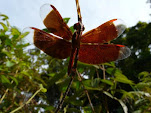Briefy, the sludge beds are the old settling pools area from the Exeter sewage works - a land use that has traditionally attracted birds and birders alike. The sewage works have long since moved to more modern techniques of treatment, and of course everything associated with them is now fenced off to prevent random numpties from falling in. The old beds, however, have been turned over to the Devon Wildlife Trust, who leave them part-flooded, with a mix of willow carr and reedbed.
 (part of the boardwalk through the sludge beds reserve)
(part of the boardwalk through the sludge beds reserve)Inside the reserve, the wind was buffered by the trees to some extent, and I was able to get into a couple of flocks of mixed passerines - handy being able to cling to branches with your toes, I've found.
Not much amongst them, beyond a quartet of Chiffchaff flicking and flycatching their way around the sunny patches and a couple of the resident Cetti's Warblers exploding with indignation at my intrusion. Frustrating point of the day came when I caught a very brief glimpse of what was most likely a Yellow-browed Warbler in an ivy-clad oak: it stuck it's head out from behind a leaf and then vapourised.
My return journey was brightened by a rather tame Goldfinch feeding on teasel, which allowed me one photo only, and the disturbing sight of Japanese knotweed (Fallopia japonica) seeding madly in the sunshine...


(Goldfinch Carduelis carduelis) and Japanese knotweed seeds. Vile invader...



No comments:
Post a Comment